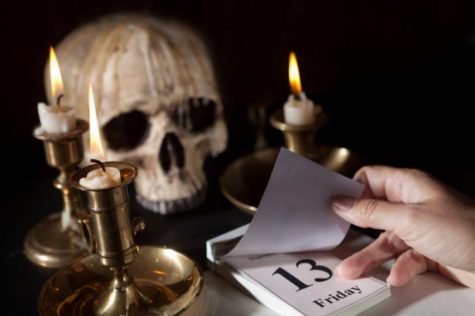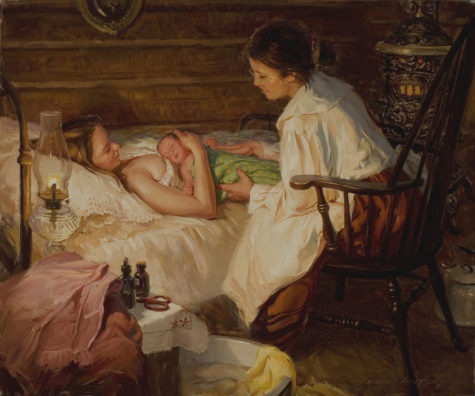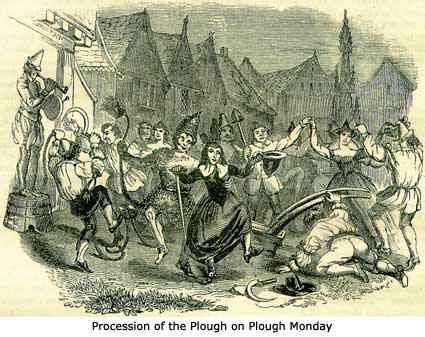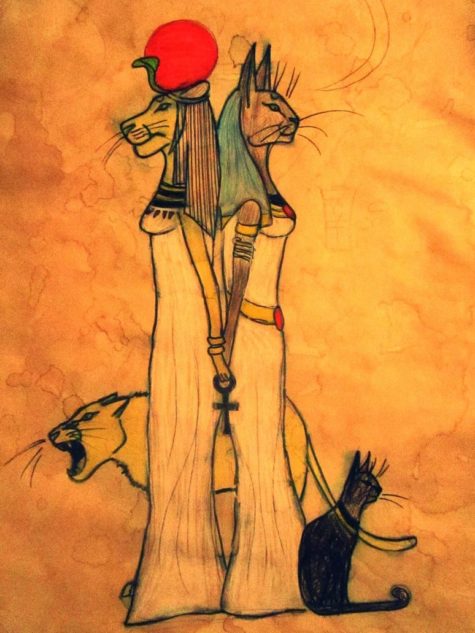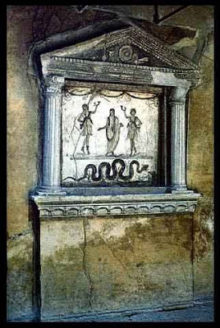Monthly Archives: January 2017
Friday the 13th occurs when the thirteenth day of a month falls on a Friday, which superstition holds to be a day of bad luck. In the Gregorian calendar, this day occurs at least once, but at most three times a year. Any month’s 13th day will fall on a Friday if the month starts on a Sunday.
There are a lot of people that are superstitious about Friday the 13th. However not many have a full understanding of the significance of this day. It has been suggested that Friday has been considered an unlucky day because, according to Christian scripture and tradition, Jesus was crucified on a Friday.
Several theories have been proposed as to why Friday the 13th is considered to be unlucky One theory is that it is a combination of two older superstitions:
- Thirteen is an unlucky number
- Friday is an unlucky day
Put the two together, and you have a doubly unlucky day. Add to it the fact that it doesn’t happen often, and it makes for some wonderful stories of doom.
Why 13 is an unlucky number:
In numerology, the number twelve is considered the number of completeness, as reflected in the twelve months of the year, twelve hours of the clock, twelve tribes of Israel, twelve Apostles of Jesus, twelve gods of Olympus, etc., whereas the number thirteen was considered irregular, transgressing this completeness. There is also a superstition, thought by some to derive from the Last Supper or a Norse myth, that having thirteen people seated at a table will result in the death of one of the diners.
Why is Friday an unlucky day?
Friday has been considered an unlucky day at least since the 14th century’s The Canterbury Tales, and many other professions have regarded Friday as an unlucky day to undertake journeys or begin new projects. Black Friday has been associated with stock market crashes and other disasters since the 1800’s. It has also been suggested that Friday has been considered an unlucky day because, according to Christian scripture and tradition, Jesus was crucified on a Friday.
Here’s one theory:
The actual origin of the superstition, appears also to be a tale in Norse mythology. Friday is named for Frigga, the free-spirited goddess of love and fertility. When Norse and Germanic tribes converted to Christianity, Frigga was banished in shame to a mountaintop and labeled a witch. It was believed that every Friday, the spiteful goddess convened a meeting with eleven other witches, plus the devil — a gathering of thirteen — and plotted ill turns of fate for the coming week.
For many centuries in Scandinavia, Friday was known as “Witches’ Sabbath.” with Friday the 13th having an even deeper more sinister significance.
But maybe it’s not unlucky at all!
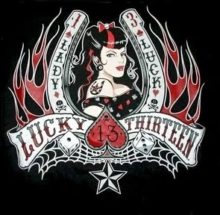 In fact Friday the 13th can be a very lucky day. Friday is also associated with Venus, the Roman Goddess of love, beauty and fertility and Friday is viewed by many pagans as the best day to perform any magick relating to Venus’ areas of expertise: love, fertility and beauty.
In fact Friday the 13th can be a very lucky day. Friday is also associated with Venus, the Roman Goddess of love, beauty and fertility and Friday is viewed by many pagans as the best day to perform any magick relating to Venus’ areas of expertise: love, fertility and beauty.
The number 13 has been a magical number since the the Ancient Egyptians first depicted the Ladder to Eternal Life. They believed that there were twelve steps on the ladder to eternal life and knowledge and to take the thirteenth step meant going through death into everlasting life. Thirteen, for the Egyptians, was associated with immortality.
The number 13 in the Coperos religion (small culture in brazil) is like a God number. All coperos must know that this number can save the humankind. In Sikhism, the number 13 is considered a special number since 13 is tera in Punjabi, which also means “yours” (as in, “I am yours, O Lord”).
There are other significances of the number 13:
- There are thirteen Moon cycles in a year
- The ancient Lunar calendar had 13 months
- A traditional coven has 13 members
- Romans require 13 guests be present at weddings
- In the Hebrew faith age 13 is considered to be an adult
- There are 13 players on a rugby team
- There are 13 cards of each suit in a deck of cards
The Knights Templar and Friday the 13th:
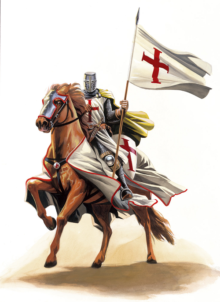 Another theory about the origin of the superstition traces the event to the arrest of the legendary Knights Templar.
Another theory about the origin of the superstition traces the event to the arrest of the legendary Knights Templar.
The Knights Templar were a monastic military order founded in Jerusalem in 1118 C.E. Their original mission was to guide and protect Christian pilgrims along the path from Europe to Jerusalem during the Crusades. Through this mission, the Templars developed a banking system to protect the finances of the traveling pilgrims, then expanded this system throughout their holdings in Europe.
Over time, France’s Philip IV of France amassed a debt to the Knights Templar for years of service. He had nearly depleted his money due to his ongoing battles with England. King Phillip became envious of the Knights Templar and their rise to power, so he set his sights on their famed fortunes. Philip devised a plan to arrest all the Knights Templar and charge them with crimes so devastating that no person or group would come to their defense.
The charges against them were religious in nature and backed by the papacy of the Vatican and Pope Clement V. His plan had to be swift and carefully put together so as to not alert the Templars in advance.
King Phillip’s orders were sent a month in advance to the King’s Men and other Bailiffs. They were not to be opened till dawn on Friday, October 13, 1307. The charges against the Templars were of the highest accusations of heresy: that the Knights Templar asked members to spit on the cross and step on it, to deny Christ, to perform homosexual acts, and so on. The king’s orders were to engage and arrest every Templar in France. All Templar outposts, homes, wineries, mills, and castles were to be taken in the name of the King of France and Pope Clement V.
This nationwide arrest was widely successful, and medieval torture tactics were used to obtain confessions from the Knights. This single act against the Templar Order is now viewed as one of the most unlucky days in History – Friday the 13th.
King Phillip attempted to further bury the Templars in a public manner: a large event in front of the Notre Dame Cathedral would have Templar Grand Master Jacques De Molay publicly admit guilt of heresy. Instead, the defeated grandmaster took to his forum and apologized to the people and Templar Knights for his weakness and for signing forced confessions. He then rescinded his original confession and testified to the public that he, his men, and all Templar Knights were innocent, despite their forced confessions.
An embarrassed King Phillip was enraged by the old man’s actions and had him burned at the stake along with his second-in-command. De Molay’s dying last words were to curse King Phillip and Pope Clement V, claiming that by the year’s end they both would meet their demise.
To add to the superstition of the Friday the 13th and to the power of the Templars both men did die that year.
More on the subject:
The connection between the Friday the 13th superstition and the Knights Templar was popularized in the 2003 novel The Da Vinci Code. However, some experts think that it is a relatively recent correlation and is a modern-day invention. For example, records of the superstition are rarely found before the 20th century, when it became extremely common. One author, noting that references are all but nonexistent before 1907 but frequently seen thereafter, has argued that its popularity derives from the publication that year of Thomas W. Lawson’s popular novel Friday, the Thirteenth, in which an unscrupulous broker takes advantage of the superstition to create a Wall Street panic on a Friday the 13th.
Interestingly, Tuesday the 13th (Martes y Trece) is also considered unlucky in some countries.
Source: Wikipedia
The ancients honored their midwives today (January 8) as the goddess’s assistants by giving them gifts. In modern times, this might equate to sending a thank-you note to your physician or pediatrician.
- Patron Goddess: Eleithyia
- Themes: Birth; Children; Creativity; Fertility
- Symbols: A Torch; White Flowers
About Eleithyia:
As the aegean goddess of birth, Eleithyia acts as the midwife to your new year, filling it with creative power. Eleithyia’s name translates as “Fluid of Generation,” giving her strong fertile aspects, and she also has a hand in personal fate.
According to myth, Eleithyia was the midwife of the gods and even birthed Eos, the creative force behind all things. When Eleithyia’s hands were closed, birth was delayed. When Eleithyia opened her body, a child arrived effortlessly.
For more information on this goddess, visit Eleithyia on The Powers That Be.
To bring Eleithyia’s fertility to any area of your life, try this spell:
Gather a handful of white flower petals. Work in an area that somehow represents your goal. If you want a fertile garden, for example, cast this spell in your garden; for fertile ideas, perform it in your study. Visualize your goal as you release all but one petal, turning clockwise to the winds, saying:
The wish of my heart, Eleighyia see,
and bring back to me fertility.
Carry the last petal to help the magic manifest.
Source: 365 Goddess
In Belgium, the Monday after Epiphany is called “lost Monday” and is a day of universal idleness. Hence probably has arisen the custom, not confined, however, to Belgian workmen alone, of idling every Monday or as they call it “making blue Monday.”
Plough-Monday is the first Monday after Twelfth Day (6th of January), so the date varies from year to year. It is so called because, the Christmas holidays being over, the men return to their plough or daily work. It was customary on this day for farm laborers to draw a plough—called “white” on account of the mummers being dressed in white, gaudily trimmed with flowers and ribbons—through the parish, soliciting “plough-money,” which would be spent in a frolic. The queen of the feast was called Bessy. The plough was also called “fond” or “fool,” because the procession is fond or foolish, not serious nor of a business character.
Dressed in clean white smocks decorated with ribbons, the men dragged a plow (plough) through the village and collected money for the “plow light” that was kept burning in the church all year. Often men from several farms joined together to pull the plow through all their villages. They sang and danced their way from village to village to the accompaniment of music. In the evening, each farmer provided a Plough Monday supper for his workers, with plentiful beef and ale for all.
Some accounts depict something far more like Hallowe’en or carnival—men going door to door in outlandish disguise, singing and demanding a gift, and if they were given nothing, ploughing up the front garden. It seems likely that the original rite, like many such door-to-door seasonal processions, had both aspects—the plough was processed because it brought blessings, but ribaldry attended the celebrations and lack of respect for the plough and its attendants brought retribution. I assume the plough was blessed first, before being taken around.
Found in: Encyclopaedia of Superstitions and Almanac.com
Christmas in Russia is celebrated on 7 January and marks the birthday of Jesus Christ. Christmas is mainly a religious event in Russia. On Christmas Eve (6 January), there are several long services, including the Royal Hours and Vespers combined with the Divine Liturgy. The family will then return home for the traditional Christmas Eve “Holy Supper”, which consists of 12 dishes, one to honor each of the Twelve Apostles. Devout families will then return to church for the “всенощная” All Night Vigil. Then again, on Christmas Morning, for the “заутренняя” Divine Liturgy of the Nativity. Since 1992 Christmas has become a national holiday in Russia, as part of the ten-day holiday at the start of every new year.
During the early-mid Soviet period, religious celebrations were discouraged by the official state policy of atheism until 1936. Christmas tree and related celebrations were gradually eradicated after the October Revolution. In 1935, in a surprising turn of state politics, the Christmas tradition was adopted as part of the secular New Year celebration. These include the decoration of a tree, or “ёлка” (spruce), festive decorations and family gatherings, the visit by gift-giving “Ded Moroz” (Дед Мороз “Grandfather Frost“) and his granddaughter, “Snegurochka” (Снегурочка “The Snowmaiden”).
Snowflake, a variation of The Snowmiden stories can be found here: Snowflake.
Principal dishes on the Christmas table in old Russia included a variety of pork (roasted pig), stuffed pig’s head, roasted meat chunks, jelly (kholodets), and aspic. Christmas dinner also included many other meats: goose with apples, sour cream hare, venison, lamb, whole fish, etc. The abundance of lumpy fried and baked meats, whole baked chicken, and fish on the festive table was associated with features of the Russian oven, which allowed successful preparation of large portions.
Finely sliced meat and pork was cooked in pots with semi-traditional porridge. Pies were indispensable dishes for Christmas, as well as other holidays, and included both closed and open style pirogi (pirozhki, vatrushkas, coulibiacs, kurnik, boats, saechki, shangi), kalachi, cooked casseroles, and blini. Fillings of every flavor were included (herbal, vegetable, fruit, mushrooms, meat, fish, cheese, mixed).
Sweet dishes served on the Russian Christmas table included berries, fruit, candy, cakes, angel wings, biscuits, honey. Beverages included drinking broths (kompot and sweet soups, sbiten), kissel, and, from the beginning of the 18th century, Chinese tea.
Source: Wikipedia
This bready, donut-shaped cake is decorated with dried fruits and spiked with a non-edible representation of the baby Jesus. Rosca de reyes is traditionally eaten on January 6 to commemorate the biblical story of the arrival of the Three Kings, (Three Kings Day). Finding the baby Jesus in your slice of cake is an honor – one the recipient celebrates by throwing a party on February 2 with tamales and atole for all guests.
Ingredients:
- 1 (1/4-ounce) packet active dry yeast
- 1/4 cup warm water
- 1/4 cup dried figs, cut into strips, plus more for garnish
- 1/4 cup candied orange peel, cut into strips, plus more for garnish
- 1/4 cup candied lemon peel, cut into strips, plus more for garnish
- 1/4 cup chopped candied cherries, plus more whole for garnish
- 2 tablespoons light rum
- 1/4 cup milk
- 1/4 cup sugar
- 1/4 cup (1/2 stick) unsalted butter
- 1 teaspoon pure vanilla extract
- 1/4 teaspoon ground cinnamon
- 1 teaspoon salt
- 3 1/2 to 4 cups all-purpose flour
- 3 large eggs, divided
- Water
- Small ceramic Jesus figurine or coin to represent Jesus
Instructions:
In a small bowl, combine the yeast and warm water; stir to blend. Let stand until the yeast comes alive and starts to foam, about 5 to 10 minutes. Put all of the candied fruit in small bowl and drizzle the rum on top. Let stand for 15 minutes to 1 hour to infuse the flavor.
In a small pot, warm the milk over medium heat. Add the sugar, butter, vanilla, cinnamon, and salt.
In a large bowl, mix 3 1/2 cups flour, 2 eggs, yeast mixture, milk mixture, and the rum soaked candied fruits, mixing very well until the dough gathers into a ball. If the dough is too wet, Add additional flour, a little at a time, if needed to form a soft dough. Turn the dough out onto a lightly floured surface and knead until it’s smooth and elastic, about 5 minutes. Put the ball of dough back into the bowl and cover with plastic wrap or a kitchen towel and set aside in a warm spot to rise for 1 hour.
Remove the dough from the bowl and knead on a lightly floured surface. Using your palms, roll the dough into a long rope. Shape the coil into a ring, sealing the ends together. Insert a little doll or coin into the bread from the bottom. Line a baking pan with aluminum foil and coat with nonstick cooking spray. Carefully transfer the dough ring to the prepared baking pan.
Preheat the oven to 350 degrees F.
Beat the remaining egg in a small bowl with 1 tablespoon of water to make an egg wash, and brush the top of the bread. Decoratively garnish the top of the bread with more candied fruit and bake for 35 to 40 minutes until the cake is golden. Cool on a wire rack before slicing.
Cook’s Note: Let your guests know there is a little doll or coin inserted inside.
Recipe courtesy of Ingrid Hoffmann
Santa Claus may have gone back to the North Pole to rest, but it doesn’t mean the gift-giving (and receiving) is over — at least not for the thousands of children in Latin America and Spain anxiously awaiting“El Día de los Reyes” Celebration on Jan. 6th.
- Children leave their shoes right outside their doors so the Three Kings will leave their gifts inside, the bigger presents are placed around them.
- Many families leave a box of grass (or hay) and water for The Three King’s camels to eat. Similar to the tradition of leaving out cookies and milk for Santa Claus. Camels are known for being a bit sloppy and leaving a trail of hay behind that children can often follow to their gifts!
- Hispanic families will usually celebrate Three Kings Day with a scrumptious dinner that is topped off with the King’s Bread (Rosca de Reyes) for dessert. Children also sometimes make crowns to wear at the table in honor of the kings.
For many Christians, the holiday season doesn’t officially end until the 12th day of Christmas known as the “Feast of the Epiphany” or “Three Kings’ Day”.
The holiday marks the biblical adoration of baby Jesus by the three Kings, also referred to as three Wise Men or Magi. According to the Gospel of Matthew, the men found the divine child by following a star across the desert for twelve days to Bethlehem. Melchior, Caspar, and Balthazar — representing Europe, Arabia, and Africa respectively — traveled by horse, camel, and elephant in order to present baby Jesus with three symbolic gifts.
- Gold
- Frankincense
- Myrrh
The gold offered by one of the wise men is a symbolic acknowledgment of Jesus’ royal standing as “King of the Jews,” while the frankincense manifests the divine nature of the baby’s existence, since he is not an earthly king but the Son of God. And finally the myrrh, often used to embalm corpses, was gifted to the newborn as a symbol of Jesus’ mortality — foreshadowing his death as a means to cleanse humanity of its sins.
Reyes festivities come in different shapes and sizes across the globe from community parades to three-day celebrations at Disneyland. In Mexico, thousands gather every year to taste a mile-long “Rosca de Reyes” (Kings’ Bread) while others simply make the holiday staple at home honoring the tradition to hide a baby Jesus figurine within the bread — the person whose slice has the figurine must prepare tamales for everyone on the Day of the Candles on Feb. 2!
Source: Huffington Post
In Italian folklore, Befana is an old woman who delivers gifts to children throughout Italy on Epiphany Eve (the night of January 5) in a similar way to St Nicholas or Santa Claus.
In popular folklore Befana visits all the children of Italy on the eve of the Feast of the Epiphany to fill their socks with candy and presents if they are good, or a lump of coal or dark candy if they are bad. In many poorer parts of Italy and in particular rural Sicily, a stick in a stocking was placed instead of coal. Being a good housekeeper, many say she will sweep the floor before she leaves. To some the sweeping meant the sweeping away of the problems of the year. The child’s family typically leaves a small glass of wine and a plate with a few morsels of food, often regional or local, for the Befana.
Befana is invoked in many Italian spells, especially those for good fortune. She brings sweets for children but may be persuaded to bring the sweetness of life to adults as well.
- On Epiphany Eve, write her a note expressing your desires.
- Place it beneath a red witch-shaped candle and burn.
- Accompany with offerings.
She is usually portrayed as a hag riding a broomstick through the air wearing a black shawl and is covered in soot because she enters the children’s houses through the chimney. She is often smiling and carries a bag or hamper filled with candy, gifts, or both. Popular tradition tells that if one sees La Befana one will receive a thump from her broomstick, as she doesn’t wish to be seen. This aspect of the tradition may be designed to keep children in their beds.
She is also referred to as the Christmas Witch. Continue reading
In ancient Egypt, the saving of mankind was commemorated every year on the feast day of Hathor/Sekhmet (Jan 7). Everyone drank beer stained with pomegranate juice and worshiped
“the Mistress and lady of the tomb,
gracious one,
destroyer of rebellion,
mighty one of enchantments“
A statue of Sekhmet was dressed in red facing west, while Bast was dressed in green and faced east. Bast was sometimes considered to be Sekhmet´s counterpart (or twin depending on the legend), and in the festival of Hathor they embodied the duality central to Egyptian mythology. Sekhmet represented Upper Egypt while Bast represented Lower Egypt.
- Note:
The dates for this feast day vary widely. In the book, Festivals of Light, August 7 is given as the Inebriety of Hathor, with a similar description of the festivities.
 The Compitalia, a festival thought to be older than Rome itself, was held in mid January (January 12th) to honor the guardian spirits of local communities or neighborhoods. Sacrifices and offerings of honey cakes were made to the Lares Compitales at any place where two roads met.
The Compitalia, a festival thought to be older than Rome itself, was held in mid January (January 12th) to honor the guardian spirits of local communities or neighborhoods. Sacrifices and offerings of honey cakes were made to the Lares Compitales at any place where two roads met.
In the countryside the ritual started at nightfall. Each family placed the statue of the underworld goddess Mania at the door of their house.They also made and hung woolen dolls representing men and women, along with strands of garlic and poppies. Slaves offered balls of wool with differing colors, to distinguish gender, rather than human figures. These were accompanied with humble requests that the Lares and Mania would be contented with the figures, thus ensuring the safety of the lives of the people inside the home.
In later years, strands of garlic and poppies were added to the offerings both on the doorways and at the crossroads.
Collected from Wikipedia and various other sources
January 5 is the Festival of the Lares Compitales. Lares are the Roman guardian spirits of house and fields, ancient Roman deities protecting the house and the family — household gods. The Lares were worshiped in small sanctuaries or shrines, called Lararium, which could be found in every Roman house. They were placed in the atrium (the main room) or in the peristylium (a small open court) of the house. Here people sacrificed food to the Lares on holidays.
Presumed to be sons of Mercury and Lara, Lares are beneficent and friendly spirits, and deeply venerated by ancient Romans. In every house there was at least one little statue, and through these small statues, the Lare was presumed to take part in all that happened inside the house. Often a statue was put on the table during the meals, and other small statues were often placed in the higher places of the house, far from the floor, or even on the roof.
There were many different types of guardians. The most important are the Lares Familiares (guardians of the family), Lares Domestici (guardians of the house), Lares Patrii (guardians of the fathers) and Lares Privati (personal guardians). Other guardians were the Lares Permarini (guardians of the sea), Lares Rurales (guardians of the land), Lares Compitales (guardians of crossroads), Lares Viales (guardians of travelers) and Lares Praestitis (guardians of the state).
The Lar Familiaris protected all household members, free or slave, and was associated with a particular place, thus did not accompany a family who moved. Tradition holds that a family’s Lar would generously help those who honored him by devotionals and sacrifices. But the Lar would turn his back to those who would not offer him thanks or neglected him.
A household’s lararium, a shrine to the Lares Familiaris, usually stood near the hearth or in a corner of the atrium. A lararium often had the appearance of a cupboard or a niche containing a small statue, a niche painted on a wall, or a small freestanding shrine. Sometimes the Genius of the head of the household, pictured as a bearded or crested snake, or as a man with the fold of his toga covering his head, is depicted with the Lar.
The Lares themselves are usually depicted as dancing youths, with a horn cup in one hand and a bowl in the other. As progenitors of the family, they were accompanied by symbolic phallic serpents.
Compitalia – The Festival of the Lares celebrated the Lares Compitales, or local guardian spirits, of the crossroads. The crossroads were the traditional setting for the veneration of the Lares and shrines were set up where crossroads met. The date of this festival marked the end of the Roman agricultural year.
The worship of the Lares included setting little towers with an altar placed before them. Archaeologists Lesley and Roy Adkins note (in their book Dictionary of Roman Religion) that the Lare shrine at the crossroads was “open in all four directions to allow passage for the Lar”.
The ancient writer Ovid, in his work titled Fasti, refers to the Lares as the “night watchmen”. Here we can see the theme of four towers associated with the four directions, as well as four guardians of boundaries or demarcation. This general theme appears in modern Wicca as the Watchers and Watchtowers of the ritual circle. An older system seemingly related to the Lares appears in Italian witchcraft where we find beings known as the Grigori. In Kabbalah based systems of magic the theme of four guardians takes the form of the four archangels Michael, Gabriel, Raphael and Ariel or Uriel. They are seen as guarding the four directions.
Collected from various sources including:
Encyclopedia Mythica, World Lingo, and Ask Jeeves.
